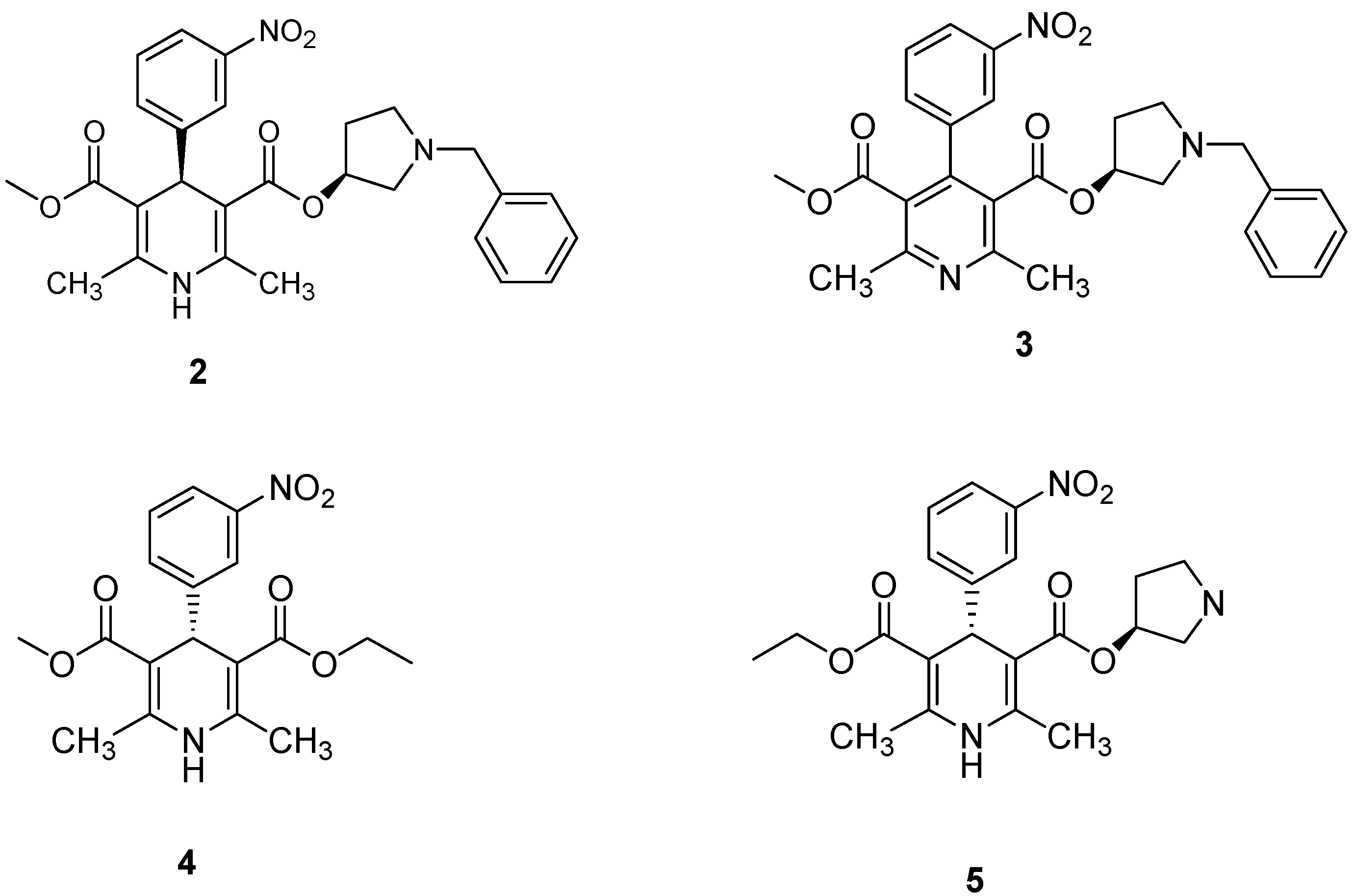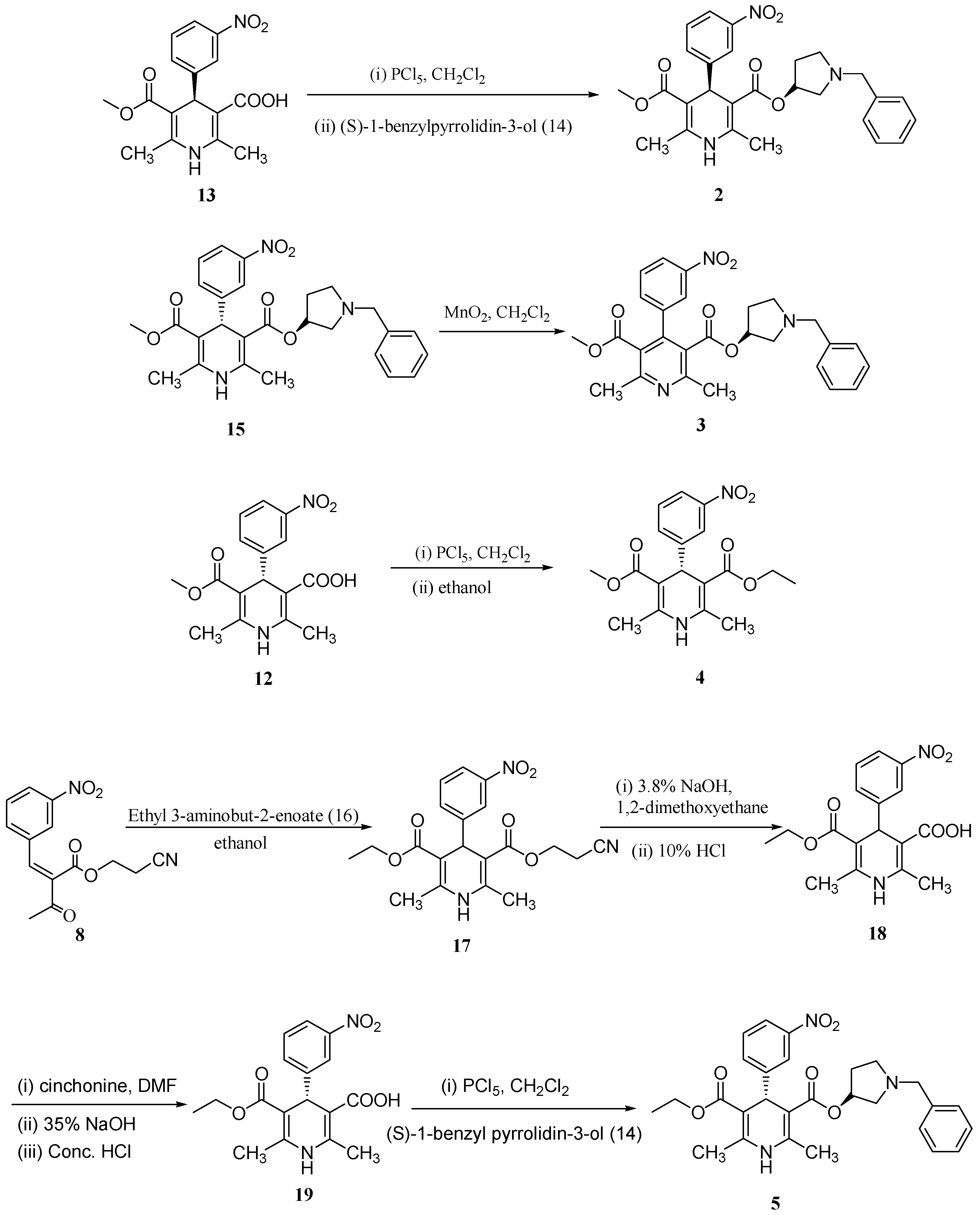Synthesis and Characterization of Impurities of Barnidipine Hydrochloride, an Antihypertensive Drug Substance
Abstract
:1. Introduction


2. Results and Discussion
 −25.9 (c 0.005 g/mL, acetone)) was obtained in 75.3% yield by resolution of compound 11 using cinchonine as the resolving agent. Condensation of compound 12 with (S)-1-benzylpyrrolidin-3-ol (14), and subsequent salt formation of the resulting barnidipine (15), provided the desired barnidipine hydrochloride (1, optical purity 99.8%) in 65.5% yield (
−25.9 (c 0.005 g/mL, acetone)) was obtained in 75.3% yield by resolution of compound 11 using cinchonine as the resolving agent. Condensation of compound 12 with (S)-1-benzylpyrrolidin-3-ol (14), and subsequent salt formation of the resulting barnidipine (15), provided the desired barnidipine hydrochloride (1, optical purity 99.8%) in 65.5% yield (  +116.5 (c 0.01 g/mL, MeOH)).
+116.5 (c 0.01 g/mL, MeOH)).

3. Experimental
General Information
4. Conclusions
Supplementary Materials
Acknowledgments
Author Contributions
Conflicts of Interest
References
- Huh, W.S.; Kim, Y.S.; Han, J.S.; Kim, S.G.; Kim, S.B.; Park, J.S.; Yamamoto, M. Antihypertensive efficacy and tolerability of barnidipine hydrochloride in patients with renal parenchymal hypertensio. Curr. Ther. Res. 2000, 61, 395–405. [Google Scholar] [CrossRef]
- Imai, Y.; Abe, K.; Nishiyama, A.; Sekino, M.; Yoshinaga, K. Evaluation of the antihypertensive effect of barnidipine, a dihydropyridine calcium entry blocker, as determined by the ambulatory blood pressure level averaged for 24 h, daytime, and nigttime. Am. J. Hypertens. 1997, 10, 1415–1419. [Google Scholar]
- Tamazawa, K.; Arima, H.; Kojima, T.; Isomura, Y.; Okada, M.; Fujita, S.; Furuya, T.; Takenaka, T.; Inagaki, O.; Terai, M. Stereoselectivity of a potent calcium antagonist, 1-benzyl-3-pyrrolidinyl methyl 2,6-dimethyl-4-(m-nitrophenyl)-1,4-dihydropyridine-3,5-dicarboxylate. J. Med. Chem. 1986, 29, 2504–2511. [Google Scholar] [CrossRef]
- Kojima, T.; Takenaka, T. 1,4-Dihydropyridine-3,5-dicarboxylic Acid Ester Derivatives. U.S. Patent 4220649.
- ICH Harmonised Tripartite Guideline: Impurities in new drug substances Q3A(R2). In Proceedings of the International Conference on Harmonization of Technical Requirements for Registration of Pharmaceuticals for Human Use, Geneva, Switzerland, 25 October 2006.
- Inagaki, O.; Asano, M.; Takenaka, T. In vitro and in vivo vasodilatory activity of barnidipine and its enantiomers. Biol. Pharm. Bull. 1999, 22, 151–156. [Google Scholar] [CrossRef]
- Pawula, M.; Watson, D.; Teramura, T.; Watanabe, T.; Higuchi, S.; Cheng, K.N. Sensitive and specific liquid chromatographic-tandem mass spectrometric assay for barnidipine in human plasma. J. Chrom. B Biomed. Sci. Appl. 1998, 719, 113–123. [Google Scholar] [CrossRef]
- Ioele, G.; Oliverio, F.; Andreu, I.; de Luca, M.; Miranda, M.A.; Ragno, G. Different photodegradation behavior of barnidipine under natural and forced irradiation. J. Photochem. Photobiol. A Chem. 2010, 215, 205–213. [Google Scholar] [CrossRef]
- Li, L.; Cheng, Z.; Li, X.; Gao, J.; Su, C.; Ma, X. Synthesis Process of Barnidipine Hydrochloride. CN Patent 101643469, 2010. [Google Scholar]
- Sample Availability: Not available.
© 2014 by the authors. Licensee MDPI, Basel, Switzerland. This article is an open access article distributed under the terms and conditions of the Creative Commons Attribution license ( http://creativecommons.org/licenses/by/3.0/).
Share and Cite
Cheng, Z.-G.; Dai, X.-Y.; Li, L.-W.; Wan, Q.; Ma, X.; Xiang, G.-Y. Synthesis and Characterization of Impurities of Barnidipine Hydrochloride, an Antihypertensive Drug Substance. Molecules 2014, 19, 1344-1352. https://doi.org/10.3390/molecules19011344
Cheng Z-G, Dai X-Y, Li L-W, Wan Q, Ma X, Xiang G-Y. Synthesis and Characterization of Impurities of Barnidipine Hydrochloride, an Antihypertensive Drug Substance. Molecules. 2014; 19(1):1344-1352. https://doi.org/10.3390/molecules19011344
Chicago/Turabian StyleCheng, Zhi-Gang, Xu-Yong Dai, Li-Wei Li, Qiong Wan, Xiang Ma, and Guang-Ya Xiang. 2014. "Synthesis and Characterization of Impurities of Barnidipine Hydrochloride, an Antihypertensive Drug Substance" Molecules 19, no. 1: 1344-1352. https://doi.org/10.3390/molecules19011344
APA StyleCheng, Z.-G., Dai, X.-Y., Li, L.-W., Wan, Q., Ma, X., & Xiang, G.-Y. (2014). Synthesis and Characterization of Impurities of Barnidipine Hydrochloride, an Antihypertensive Drug Substance. Molecules, 19(1), 1344-1352. https://doi.org/10.3390/molecules19011344



